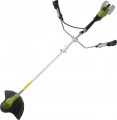Line diameter
The diameter of the fishing line supplied with the trimmer (more precisely, with a reel attachment, see "Tips").
In modern models, this parameter can be from 1 to 4 mm. At the same time, a thicker fishing line handles better with dense thickets, but it works rougher, the treated lawn is not particularly even, and for the effective operation of such a nozzle, a fairly powerful engine is needed. On the other hand, a fine line provides a clean and neat cut, but is not suitable for heavy vegetation and large stems. Thus, thick fishing line is usually equipped with powerful units designed for "launched" lawns with an abundance of thick stems. Thin, on the other hand, is found mainly in low-power electric trimmers with a lower engine location, designed for neat lawns with regularly cut grass.
We also recall that many trimmers have the ability to replace the standard reel with another one that differs in line thickness.
Soft start
The presence of a
soft start system in the lawn mower engine.
The design features of electric motors are such that when power is applied directly, the start occurs very abruptly — both in a mechanical and electrical sense. Firstly, the engine itself spins up in a jerk, in a very short time, which increases the wear of its parts. Secondly, at the moment of start-up, there is a sharp jump in current strength, which creates significant loads on the power grid (or the batteries of the unit). The soft start system eliminates these phenomena: it limits the starting current, allowing the motor to accelerate smoothly and preventing voltage surges.
On the other hand, additional electronic circuits affect the cost, sometimes quite significantly. So there are few models with this feature nowadays, and you should pay attention to them mainly in cases where the mentioned advantages are of fundamental importance — for example, if the device is purchased for a house with weak wiring that does not tolerate voltage surges.
Battery platform
The name of the battery platform supported by the device. A single battery platform is used to combine various power tools of the same brand (drill, grinder, saw, etc.) into one line. Devices on the same platform use interchangeable batteries and chargers. Thanks to this, for example, there is no need to select a battery for each individual model of a power tool, because one purchased as a spare battery can be used in various power tools, depending on the situation or as needed. Batteries of the same platform basically differ from each other except perhaps in capacity.
Powered by two batteries
The device is powered
by two batteries at once.
For battery models in general, see above. And this feature means that due to its high power characteristics, a single standard battery is not enough for a lawn mower.
Noise level
The level of noise produced by the device during operation. Usually, a certain average indicator is indicated in the characteristics — in the standard mode of operation; however, the actual values usually do not differ much from the claimed ones.
The lower the noise level, the more convenient the unit to use and the less tired the operator. In the case of lawn mowers, this is especially true, since such equipment is quite noisy — even the quietest models (some robots) give out about 47 – 48 dB, which is comparable to talking at an average volume. Note that the decibel is a non-linear quantity, and it is easiest to evaluate the actual loudness using comparative tables. Here is the simplest table for the values found in modern lawn mowers:
— 60 – 65 dB — talking in raised tones at a distance of about 1 m;
70 dB — loud conversation of several people at the same distance;
75 dB — loud laughter at a distance of 1 m;
80 dB — motorcycle engine, medium power vacuum cleaner.
90 dB — loud screams, freight car at a distance of 7 – 10 m;
100 dB — a subway train or a loud car signal at a distance of 5 – 7 m, an industrial workshop;
110 dB — tractor engine at a distance of about 1 m.
In addition to subjective sensations, there are specific sanitary standards that limit the impact of strong noise. So, according to European standards, noise of 85 dB is allowed to be heard without protective equipment for 8 hours, 91 dB — 2 hours, 97...dB — half an hour, and 103 dB — only 7 minutes. So when choosing a unit, you should take into account the duration of work with it — with high noise, you may need protective headphones.

